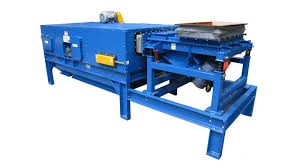
12 月 . 04, 2024 09:33 Back to list
Steel Scrap Processing Plant A Vital Component of Sustainable Manufacturing
In today’s rapidly evolving industrial landscape, the demand for sustainable practices is becoming increasingly critical. Steel scrap processing plants play a vital role in the sustainable manufacturing ecosystem by recycling metal waste and transforming it into usable raw materials. This not only conserves natural resources but also reduces energy consumption and minimizes environmental impact.
A steel scrap processing plant primarily focuses on the collection, sorting, and recycling of various types of steel scrap. Steel, as a fundamental material in construction, automotive, and manufacturing industries, is widely produced and consumed. However, post-consumption, it can generate a substantial amount of waste. This is where the processing plant steps in, ensuring that these steel by-products are efficiently recycled and repurposed.
The first step in the processing chain is the collection of scrap steel, which can come from various sources such as industrial waste, construction sites, old vehicles, and household appliances. Once collected, the scrap is brought to the facility, where it undergoes a rigorous sorting process. During this stage, different types of steel materials are separated based on their grades and compositions. This is crucial because different types of steel have varying properties and recycling processes that maximize efficiency and quality.
After sorting, the next phase involves shredding the scrap steel into smaller pieces. This is typically achieved using heavy machinery designed to handle large volumes of metal. Shredding not only reduces the size of the scrap, making it easier to transport and process, but it also helps in separating impurities such as plastic, rubber, or other materials that may be mixed with the steel.

Following shredding, the processed scrap is fed into furnaces for melting. Advanced electric arc furnaces are commonly used in modern steel processing plants, as they offer a more energy-efficient solution compared to traditional methods. These furnaces use electricity to melt the steel scrap, often resulting in lower carbon emissions and minimal environmental impact. The molten steel is then cast into various shapes, ready to be sold back to industries for manufacturing new steel products.
The capacity for steel recycling is immense. It is estimated that recycling steel can save up to 74% of the energy required to produce new steel from raw materials. Furthermore, by recycling steel scrap, plants significantly reduce the demand for mining and processing virgin iron ore, which is a resource-intensive process. The recycling of steel also has a positive impact on the economy by creating jobs and supporting local communities involved in scrap collection and processing.
Moreover, steel scrap processing plants play an essential role in reducing landfill waste. By managing the lifecycle of steel products, these facilities contribute to a circular economy whereby materials are continuously reused and repurposed. This not only helps in conserving resources but also aligns with global sustainability goals aimed at reducing waste and promoting greener manufacturing practices.
In conclusion, steel scrap processing plants are indispensable to the modern economy and environmental sustainability. They serve as crucial hubs for recycling, bringing together various aspects of industry and ecology. With the ongoing push towards more responsible manufacturing and waste management practices, the importance of these plants will only continue to grow, making them a key pillar in the quest for a sustainable future.
Latest news
Unveiling the Power of Eddy Current Separator
NewsSep.25,2024
Transform Your Home Recyclin:home metal shredder
NewsSep.25,2024
The Future of Waste Management with Recycling Line Picker
NewsSep.25,2024
The Benefits of a Metal Recycling Plant
NewsSep.25,2024
Revolutionize Material Separation with Onwang Technology
NewsSep.25,2024
Innovative Waste Management: Unveiling the MSW Sorting Plant
NewsSep.25,2024